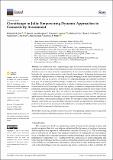| dc.contributor.author | Hall, Kimberly R. | |
| dc.contributor.author | Anantharaman, Ranjan | |
| dc.contributor.author | Landau, Vincent A. | |
| dc.contributor.author | Clark, Melissa | |
| dc.contributor.author | Dickson, Brett G. | |
| dc.contributor.author | Jones, Aaron | |
| dc.contributor.author | Platt, Jim | |
| dc.contributor.author | Edelman, Alan | |
| dc.contributor.author | Shah, Viral B. | |
| dc.date.accessioned | 2021-09-20T14:16:19Z | |
| dc.date.available | 2021-09-20T14:16:19Z | |
| dc.date.issued | 2021-03-15 | |
| dc.identifier.uri | https://hdl.handle.net/1721.1/131349 | |
| dc.description.abstract | The conservation field is experiencing a rapid increase in the amount, variety, and quality of spatial data that can help us understand species movement and landscape connectivity patterns. As interest grows in more dynamic representations of movement potential, modelers are often limited by the capacity of their analytic tools to handle these datasets. Technology developments in software and high-performance computing are rapidly emerging in many fields, but uptake within conservation may lag, as our tools or our choice of computing language can constrain our ability to keep pace. We recently updated Circuitscape, a widely used connectivity analysis tool developed by Brad McRae and Viral Shah, by implementing it in Julia, a high-performance computing language. In this initial re-code (Circuitscape 5.0) and later updates, we improved computational efficiency and parallelism, achieving major speed improvements, and enabling assessments across larger extents or with higher resolution data. Here, we reflect on the benefits to conservation of strengthening collaborations with computer scientists, and extract examples from a collection of 572 Circuitscape applications to illustrate how through a decade of repeated investment in the software, applications have been many, varied, and increasingly dynamic. Beyond empowering continued innovations in dynamic connectivity, we expect that faster run times will play an important role in facilitating co-production of connectivity assessments with stakeholders, increasing the likelihood that connectivity science will be incorporated in land use decisions. | en_US |
| dc.publisher | Multidisciplinary Digital Publishing Institute | en_US |
| dc.relation.isversionof | http://dx.doi.org/10.3390/land10030301 | en_US |
| dc.rights | Creative Commons Attribution | en_US |
| dc.rights.uri | https://creativecommons.org/licenses/by/4.0/ | en_US |
| dc.source | Multidisciplinary Digital Publishing Institute | en_US |
| dc.title | Circuitscape in Julia: Empowering Dynamic Approaches to Connectivity Assessment | en_US |
| dc.type | Article | en_US |
| dc.identifier.citation | Land 10 (3): 301 (2021) | en_US |
| dc.contributor.department | Massachusetts Institute of Technology. Department of Mathematics | |
| dc.identifier.mitlicense | PUBLISHER_CC | |
| dc.eprint.version | Final published version | en_US |
| dc.type.uri | http://purl.org/eprint/type/JournalArticle | en_US |
| eprint.status | http://purl.org/eprint/status/PeerReviewed | en_US |
| dc.date.updated | 2021-03-26T14:17:05Z | |
| dspace.date.submission | 2021-03-26T14:17:05Z | |
| mit.license | PUBLISHER_CC | |
| mit.metadata.status | Authority Work and Publication Information Needed | |
